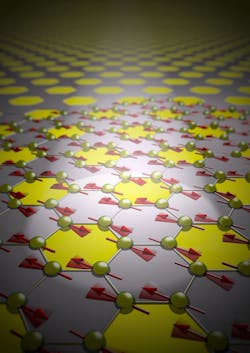Researchers demonstrate 2D magnet control using light
Much more efficient data storage and processing is possible, thanks to a new technique that uses light to change the anisotropy of van der Waals antiferromagnets on demand.
Researchers from The Netherlands, Spain, and Ukraine (led by the Delft University of Technology [TU Delft]) developed the method that essentially allows users to control the magnetic state of atomically thin van der Waals magnets in real time. Until now, such control has been difficult because, while van der Waals magnets can be incredibly strong, they don’t necessarily have strong magnetic properties—in two dimensions, “the magnetic order of these magnets becomes especially vulnerable to heat,” which could ultimately collapse the magnetic order.
In their study, the team used ultrashort pulses of light to induce the magnetic anisotropy in the two-dimensional antiferromagnet. They found that not every type of light was able to generate that magnetic anisotropy, as the color “needs to match the energy required to change the electrons’ orbital state. According to the researchers, “as the electron spin and its orbital motion are tightly linked, the light excitations induce anisotropy, which results in a two-dimensional spin-wave motion.”
Light served the researchers as a “very convenient control knob,” says Dr. Andrea Caviglia, an associate professor at TU Delft. "You can simply and swiftly turn it on and off and therefore manipulate the anisotropy on demand, which is exactly what we need if we want to start using these materials for efficient data storage."
The researchers were also able to demonstrate that anisotropy can be photoinduced for very short times—about as long as a light pulse. For practical applications, such as hyper-efficient data storage, the team notes that changes to the magnet would need to be sustained for a longer period of time. Reference: D. Afanasiev et al., Sci. Adv. (2021); doi:10.1126/sciadv.abf3096.
About the Author
Justine Murphy
Multimedia Director, Digital Infrastructure
Justine Murphy is the multimedia director for Endeavor Business Media's Digital Infrastructure Group. She is a multiple award-winning writer and editor with more 20 years of experience in newspaper publishing as well as public relations, marketing, and communications. For nearly 10 years, she has covered all facets of the optics and photonics industry as an editor, writer, web news anchor, and podcast host for an internationally reaching magazine publishing company. Her work has earned accolades from the New England Press Association as well as the SIIA/Jesse H. Neal Awards. She received a B.A. from the Massachusetts College of Liberal Arts.

